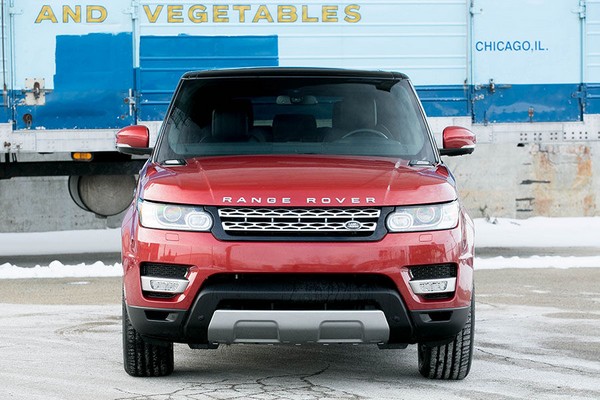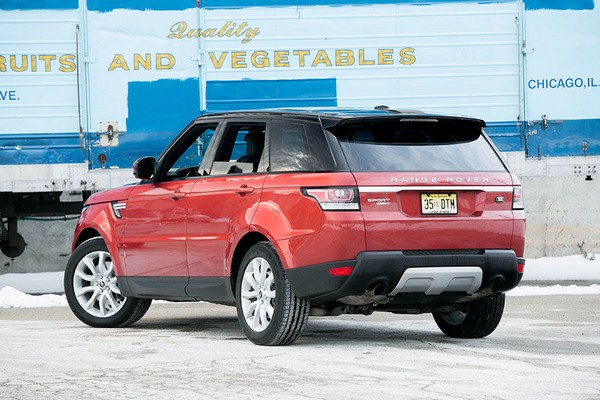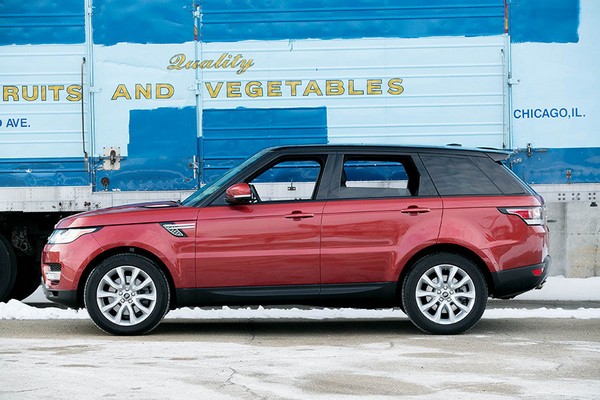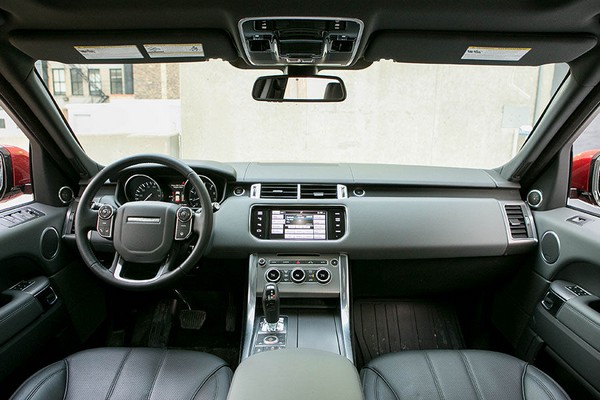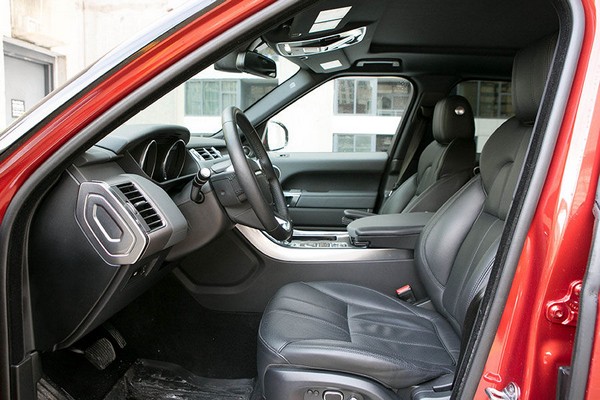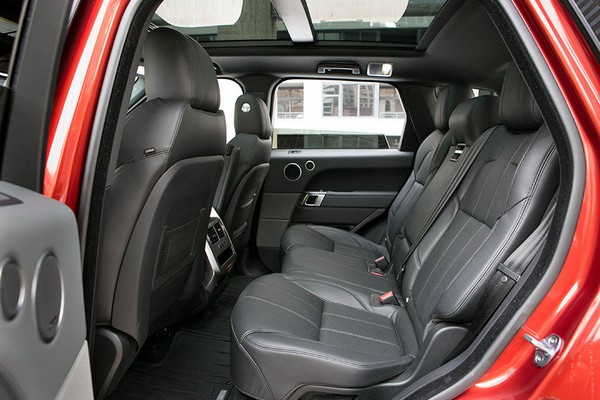What’s New for 2016
An optional turbodiesel V6 debuts on the 2016 Range Rover Sport, and the parking cameras have been upgraded. A crawl-control feature enhances off-road versatility, while a self-lowering suspension (“Auto Access Height”) eases ingress and egress when the vehicle is parked. Also newly standard are a hands-free power tailgate and a few features that were optional last year, including the InControl Apps suite, which now allows you to lock and unlock the SUV from your smartphone.
Introduction
Every vehicle is a compromise, and yet the 2016 Land Rover Range Rover Sport tries to do it all — and we’ll be darned if it doesn’t come close. Here’s a vehicle that can go from a muddy, rutted trail directly to a racetrack (a transition we’ve actually experienced in the 550-horsepower SVR model) and feel confident in both locales. Naturally, luxury is also a big part of the equation, as the Range Rover Sport coddles its occupants with comfortable seats and high-end materials throughout the cabin.
The only serious drawback to the Range Rover Sport is that it’s a real porker, tipping our scales at nearly 5,500 pounds in both the Supercharged and SVR trims. All that weight takes a toll on fuel economy, something Range Rover is addressing this year with the addition of a diesel option. The “Td6” is a 3.0-liter turbodiesel V6 producing 254 hp, and if that doesn’t sound like enough, consider that it produces 440 pound-feet of torque, 100 lb-ft more than the supercharged V6 offered in the base-model Range Rover Sport. Perhaps more importantly, it’s EPA-rated at 25 mpg combined, a refreshing change from the mid-teens we’re used to seeing in the gasoline-powered models.
Naturally, the Range Rover Sport is not alone in this profitable segment. The BMW X5has plenty of driver appeal, and like the Range Rover Sport, it’s available with a third row of seating. If racetrack aspirations aren’t as important, the Merceds Benx GLE-class (formerly known as the M-Class) is another good alternative that offers a diesel option as well. Rounding out the German trifecta is the Porsche Cayeene, which is the best athlete of the bunch and provides a broad range of engines and trim levels. That said, if you’re looking for the ultimate mix of on- and off-road ability, the 2016 Range Rover Sport remains one of the most rewarding crossovers on the road.
Body Styles, Trim Levels, and Options
The 2016 Land Rover Range Rover Sport is a midsize luxury SUV offered in six trim levels: SE, HSE, Supercharged, Supercharged Dynamic, Autobiography and SVR. Two-row seating is standard, with a two-passenger, power-folding third row optional on all trims except the SVR.
Standard features on the SE trim include 19-inch alloy wheels, xenon headlights, LED running lights and taillights, power-folding heated mirrors, a self-leveling air suspension with auto access height, front and rear parking sensors, a hands-free power liftgate, rear privacy glass and keyless ignition and entry. Inside you’ll find ambient interior lighting, leather upholstery, 14-way power front seats, driver memory settings, a power-adjustable steering wheel, an auto-dimming rearview mirror, dual-zone climate control, 60/40-split folding rear seatbacks and a cargo cover. Also standard are an 8-inch touchscreen, a navigation system, voice controls, a rearview camera, Bluetooth (phone and streaming audio), the InControl Apps suite and an eight-speaker sound system with satellite and HD radio and a USB port.
The HSE adds 20-inch wheels, foglights, a panoramic sunroof, perforated leather upholstery, heated front seats and upgraded interior trim.
The Supercharged trim level adds a V8 engine, a more sophisticated four-wheel-drive system (with low-range gearing and handling-enhancing torque vectoring), adaptive terrain-sensing drive settings (“Terrain Respone 2 Auto”), adaptive suspension dampers, roll stabilization and steering-wheel paddle shifters.
The Supercharged Dynamic model goes further with 21-inch five-spoke alloy wheels, red-painted brake calipers, a flat-screen virtual instrument cluster, increased top speed (155 mph) and unique interior trim.
The Autobiography adds unique 21-inch wheels, adaptive headlights with automatic high beams, various other exterior styling enhancements, auto-dimming exterior mirrors, 16-way power-adjustable ventilated front seats, extended leather trim, a heated steering wheel, a front console cooler box, heated rear seats, tri-zone climate control, a surround-view camera system, a blind spot monitor, rear cross-traffic alert and a 19-speaker Meridian sound system.
The high-performance SVR provides most of the Autobiography’s features, adding or substituting SVR-specific 21-inch wheels and bumpers, sport-tuned suspension and steering, sportier transmission programming, special interior and exterior styling and trim details, front sport seats and rear sport seats.
Many of the higher trims’ standard features are available on lower trims. Other options include 22-inch wheels, cooled front and rear seats, a 23-speaker Meridian audio system, quad-zone climate control, adaptive cruise control with automatic emergency braking, a towing package (with a full-size spare tire in two-row models) and a rear-seat entertainment system. A Driver Assistance package adds a head-up display, a lane-departure warning system, a self-parking system (with both parallel and perpendicular capability, plus automatic space exit) and 360-degree parking sensors.
Powertrains and Performance
The 2016 Land Rover Range Rover Sport is available with four engine choices. SE and HSE models come standard with a 3.0-liter gasoline V6 rated at 340 hp and 332 lb-ft of torque; a 3.0 liter turbodiesel producing 254 hp and 440 lb-ft of torque is optional. Supercharged and Autobiography versions come with a 5.0-liter V8 that pumps out 510 hp and 461 lb-ft of torque. The SVR gets a tweaked version of the V8 good for 550 hp and 502 lb-ft. All utilize the same eight-speed automatic transmission, though the SVR is treated to sportier programming.
At the Edmunds test track, a Range Rover Sport Supercharged sprinted from zero to 60 in a blistering 4.6 seconds. Interestingly, an SVR only improved a smidge to 4.5 seconds despite weighing 33 pounds less, calling into question its claimed power advantage.
All Range Rover Sport models are also equipped with full-time four-wheel drive. The SE and HSE come standard with a light-duty, single-speed 4WD system, while the Supercharged model is equipped with a two-speed transfer case (optional on SE and HSE) that provides high- and low-range gearing for more serious off-roading. The standard Terrain Response system features driver-selectable modes that optimize the vehicle’s powertrain, suspension and electronics for increased traction on various surfaces, while the available Terrain Response 2 Auto variant (bundled with the two-speed transfer case) includes an additional adaptive mode that automatically optimizes settings while you drive. New this year is All-Terrain Progress Control (i.e., crawl control), which maintains a preset speed (up to 20 mph) over difficult terrain.
EPA fuel economy estimates start with the gasoline V6 version, which comes in at 19 mpg combined(17 city/23 highway), a somewhat disappointing result given that Porsche’s 420-hp Cayenne S gets 20 mpg combined. The diesel produces a significantly better 25 mpg combined (22 city/29 highway). The supercharged V8 is rated at 16 mpg combined(14 city/19 highway), a predictably inefficient result for a 510-hp truck. Expect the same or a bit worse from the SVR.
All Range Rover Sports except the SVR can tow up to 7,716 pounds; the latter drops to a still-respectable 6,600 pounds.
Safety
The 2016 Range Rover Sport comes standard with antilock disc brakes, traction and stability control, front-seat side airbags and full-length side curtain airbags. Also standard are front and rear parking sensors and a rearview camera.
Available safety equipment includes adaptive cruise control with automatic emergency braking, a surround-view camera system, a blind-spot monitor with rear cross-traffic alert and lane-departure warning. The nifty self-parking system handles both parallel and perpendicular jobs, and its automatic space exit feature ensures that you won’t pull out in front of passing traffic or nudge the parked cars around you.
In Edmunds brake testing, a Range Rover Sport Supercharged came to a stop from 60 mph in 124 feet, which is about average for this class but underwhelming given the model’s sporting pretensions. An SVR model stopped in 122 feet.
Interior Design and Special Features
Land Rover made sure to spruce up the Range Rover Sport’s interior for the current generation, though some might miss the previous generation’s power-actuated dial-type gear selector (Buyers must now make do with a conventional lever.) Still, the rakish dashboard, top-notch materials and attractive wood and metal inlays add up to one of the nicest cabins in the segment. You don’t sit as high in the Sport as in other Land Rover products, but that’s by design; this is the athletic one, remember, so a snug, cockpit-like feel is the desired effect. Happily, visibility remains excellent, with plenty of glass all around.
The standard 8-inch touchscreen seems a little dated compared to some rival systems, with relatively simple graphics and occasionally slow response times. On the bright side, it’s pretty easy to use. A nice standard inclusion for 2016 is the InControl Apps system, which integrates Apple and Android smartphones in such a way that certain apps look the same on the touchscreen as they do on your device.
Seat comfort is excellent in front, and the SVR’s sport seats take lateral support to a new level. The rear outboard seats are fully adult-friendly (and again extra-sporty in the SVR), though the middle position, as usual, is only suitable for smaller occupants. As for the third row, Land Rover says it’s specifically designed for children, and they’re not kidding: It’s pretty tight back there. But the standard power-folding feature is great, allowing you to fold the seats flat or raise them into place at the touch of a button.
If we calculated cargo capacity per pound, the massive Range Rover Sport would certainly be one of the lowest-ranked SUVs. With 27.7 cubic feet of space behind the second row and a maximum of 62.2 cubes with the second-row seatbacks folded, it holds less stuff than most compact crossovers. More importantly, though, it’s neck-and-neck with the rival Cayenne. At least the space is easier to access this year, as the Range Rover Sport adds a kick-to-open feature (one doesn’t actually kick the car, tempting as that may be; waving your foot under the bumper with the key on your person will open the tailgate).
Driving Impressions
It’s hard to believe that such a heavy, high-riding crossover wouldn’t just be all over the place on winding roads. But sure enough, the 2016 Land Rover Range Rover Sport powers through with impressive confidence and stability. Is it as sharp as the Cayenne? No, and if you try to push it to the limit, the intrusive stability control system is quick to slap you down. But it’s close enough to be in the conversation, so we’d say the “Sport” in this Range Rover’s name is not misplaced. Away from civilization, meanwhile, this rig continues to impress. It may not be as capable on tough trails as the regular Range Rover, but it should be more than enough for the occasional foray into the woods.
In normal driving, the standard air suspension takes the edge off almost any surface. Road and tire noise are appropriately low for this price bracket. We wouldn’t mind a little more get-up-and-go from the base V6, but the V8s are downright thrilling when you give them the spurs. The diesel sits somewhere in the middle, suffering from some off-the-line lag but delivering a strong midrange punch for merging and passing. You can definitely hear the distinctive diesel clatter around town, but the Td6 engine is virtually silent at highway cruising speeds.
Source: Edmunds

